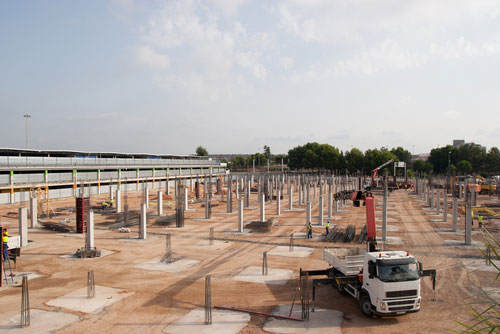3D printing is a process where 3D objects are created from a digital file. It’s also known as additive manufacturing, because unlike traditional manufacturing which involves cutting out and removing material from a piece of metal or plastic, 3D printing adds successive layers of material until the object is created.
3D printing and construction
The construction industry currently generates a vast amount of waste, and progress towards sustainability is slow. Due to the complexity of supply chains in the construction industry, green management interventions have had a limited impact. Construction projects can involve thousands of different companies, making it extremely difficult to ensure a sustainable approach is used through the whole supply chain.
But disruptive technologies such as 3D printing have the potential to change the way that products are designed and manufactured, fundamentally changing the structure of supply chains. Research shows that 3D printing can help the construction industry become leaner, more efficient, and more sustainable.
The benefits of 3D printing for construction
Ivo Kothman and Niels Faber, academics at Saxion University of Applied Sciences, argue that 3D printing technology "changes the rules of the game." As part of a two-year research programme, Kothman and Faber have been conducting research on the feasibility of 3D printing concrete, and their findings are significant. Here’s a summary of some of the key points from their research.

1. Shorter supply chain and quicker design process
On-site 3D printing means that various time-consuming steps can simply be cut out from the design process. Normally, the building design process requires input from up to five different parties including architects, engineers, contractors, clients and executive parties.
With 3D printing, all of these roles can be integrated into the role of the architect alone, with the help of simulation techniques and modelling to ensure structural integrity. 3D representations also enable consumers to visualise the design, meaning that changes can easily be implemented before the build.

2. Fewer logistical processes and less waste
Contractors interviewed in the research believe that 3D printing has the potential to eliminate three major factors relating to transportation logistics.
Firstly, many parts get damaged in transit, which could be eliminated by on-site printing. Secondly, parts must be over-engineered in order to withstand transportation, involving additional costs. On-site 3D printing would remove the need for such over-engineering. Thirdly, secure transportation and hoisting requires parts to have additional features, creating a need for additional, post-assembly work. On-site 3D printing would remove the need for these features.
Furthermore, 3D printing removes the need for wooden moulds that are used in traditional construction, because in 3D printing the raw material is directly moulded into a construction.

3. Making customised houses available to the wider market
The digitisation of a large part of the production process means that complex products can be customised at a minimal added cost.
Traditionally, constructing a house with the help of an architect has been too expensive for many consumers – not because of the cost of the architect per se, but because of the need for adapting construction methods.
With 3D printing of concrete, the actual shape that is printed is irrelevant to the cost, meaning that more people will be able to afford customised houses to meet their requirements.

4. Simpler and more efficient installation of pipes and electrics
In conventional construction, heating systems, insulation, running water and electricity all require labour-intensive on-site installation. But with 3D printing of concrete, some of these functions can become integrated in the 3D printing process.
Printing hollow walls means less materials are needed, enables improved insulation, and can potentially enable the use of 3D printed canals to transport hot or cold water. Additionally, without the need for on-site installations, a reduction in waste can be achieved.